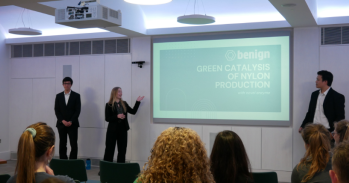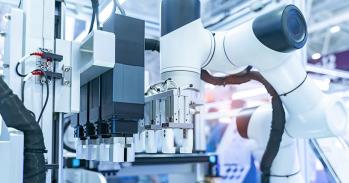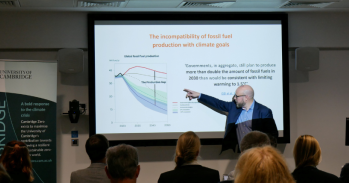
Gene editing using ‘molecular scissors’ that snip out and replace faulty DNA could provide an almost unimaginable future for some patients: a complete cure. Cambridge researchers are working towards making the technology cheap and safe, as well as examining the ethical and legal issues surrounding one of the most exciting medical advances of recent times.
Gene editing using ‘molecular scissors’ that snip out and replace faulty DNA could provide an almost unimaginable future for some patients: a complete cure. Cambridge researchers are working towards making the technology cheap and safe, as well as examining the ethical and legal issues surrounding one of the most exciting medical advances of recent times.
I’m really excited by the frontierness of it all. We feel that we’re right on the precipice of a new personalised medical future.
Alasdair Russell
Dr James Thaventhiran points to a diagram of a 14-year-old boy’s family tree. Some of the symbols are shaded black.
“These family members have a very severe form of immunodeficiency. The children get infections and chest problems, the adults have bowel problems, and the father died from cancer during the study. The boy himself had a donor bone marrow transplant when he was a teenager, but he remains very unwell, with limited treatment options.”
To understand the cause of the immunodeficiency, Thaventhiran, a clinical immunologist in Cambridge’s Department of Medicine, has been working with colleagues at the Great Northern Children’s Hospital in Newcastle, where the family is being treated.
Theirs is a rare disease, which means the condition affects fewer than 1 in 2,000 people. Most rare diseases are caused by a defect in the genetic blueprint that carries the instruction manual for life. Sometimes the mistake can be as small as a single letter in the three billion letters that make up the genome, yet it can have devastating consequences.
When Thaventhiran and colleagues at the National Institute for Health Research (NIHR) BioResource in Cambridge carried out whole genome sequencing on the boy’s DNA, they discovered a defect that could explain the immunodeficiency. “We believe that just one wrong letter causes a malfunction in an immune cell called a dendritic cell, which is needed to detect infections and cancerous cells.”
Now, hope for an eventual cure for family members affected by the faulty gene is taking shape in the form of ‘molecular scissors’ called CRISPR-Cas9. Discovered in bacteria, the CRISPR-Cas9 system is part of the armoury that bacteria use to protect themselves from the harmful effects of viruses. Today it is being co-opted by scientists worldwide as a way of removing and replacing gene defects.
One part of the CRISPR-Cas9 system acts like a GPS locator that can be programmed to go to an exact place in the genome. The other part – the ‘molecular scissors’ – cuts both strands of the faulty DNA and replaces it with DNA that doesn’t have the defect.
“It’s like rewriting DNA with precision,” explains Dr Alasdair Russell. “Unlike other forms of gene therapy, in which cells are given a new working gene but without being able to direct where it ends up in the genome, this technology changes just the faulty gene. It’s precise and it’s ‘scarless’ in that no evidence of the therapy is left within the repaired genome.”
Russell heads up a specialised team in the Cancer Research UK Cambridge Institute to provide a centralised hub for state-of-the-art genome-editing technologies.
“By concentrating skills in one area, it means scientists in different labs don’t reinvent the wheel each time and can keep pace with the field,” he explains. “At full capacity, we aim to be capable of running up to 30 gene-editing projects in parallel.
“What I find amazing about the technology is that it’s tearing down traditional barriers between different disciplines, allowing us to collaborate with clinicians, synthetic biologists, physicists, engineers, computational analysts and industry, on a global scale. The technology gives you the opportunity to innovate, rather than imitate. I tell my wife I sometimes feel like Q in James Bond and she laughs.”
Russell’s team is using the technology both to understand disease and to treat it. Together with Cambridge spin-out DefiniGEN, they are rewriting the DNA of a very special type of cell called an induced pluripotent stem cell (iPSC). These are cells that are taken from the skin of a patient and ‘reprogrammed’ to act like one of the body’s stem cells, which have the capacity to develop into almost any other cell of the body.
In this case, they are turning the boy’s skin cells into iPSCs, using CRISPR-Cas9 to correct the defect, and then allowing these corrected cells to develop into the cell type that is affected by the disease – the dendritic cell. “It’s a patient-specific model of the cure in a Petri dish,” says Russell.
The boy’s family members are among a handful of patients worldwide who are reported to have the same condition and among around 3,500 in the UK who have similar types of immunodeficiency caused by other gene defects. With such a rare group of diseases, explains Thaventhiran, it’s important to locate other patients to increase the chance of understanding what happens and how to treat it.
He and Professor Ken Smith in the Department of Medicine lead a programme to find, research and provide diagnostic services to these patients. So far, 2,000 patients (around 60% of the total affected in the UK) have been recruited and sequenced by the NIHR Bioresource, making it the largest worldwide cohort of patients with primary immunodeficiency."
“We’ve now made 12 iPSC lines from different patients with immunodeficiency,” adds Thaventhiran, who has started a programme for gene editing all of the lines. “This means that for the first time we’ll be able to investigate whether correcting the mutation corrects the defect – it’ll open up new avenues of research into the mechanisms underlying these diseases.”
But it’s the possibility of using the gene-edited cells to cure patients that excites Thaventhiran and Russell. They explain that one option might be to give a patient repeated treatments of their own gene-edited iPSCs. Another would be to take the patient’s blood stem cells, edit them and then return them to the patient.
The researchers are quick to point out that although the technologies are converging on this possibility of truly personalised medicine, there are still many issues to consider in the fields of ethics, regulation and law.
Dr Kathy Liddell, who leads the Cambridge Centre for Law, Medicine and Life Sciences, agrees: “It’s easy to see the appeal of using gene editing to help patients with serious illnesses. However, new techniques could be used for many purposes, some of which are contentious. For example, the same technique that edits a disease in a child could be applied to an embryo to stop a disease being inherited, or to ‘design’ babies. This raises concerns about eugenics.
“The challenge is to find systems of governance that facilitate important purposes, while limiting, and preferably preventing, unethical purposes. It’s actually very difficult. Rules not only have to be designed, but implemented and enforced. Meanwhile, powerful social drivers push hard against ethical boundaries, and scientific information and ideas travel easily – often too easily – across national borders to unregulated states.”
A further challenge is the business case for carrying out these types of treatments, which are potentially curative but are costly and benefit few patients. One reason why rare diseases are also known as orphan diseases is because in the past they have rarely been adopted by drug companies.
Liddell adds: “CRISPR-Cas9 patent wars are just warming up, demonstrating some of the economic issues at stake. Two US institutions are vigorously prosecuting their own patents, and trying to overturn the others. There will also be cross-licensing battles to follow.”
“The obvious place to start is by correcting diseases caused by just one gene; however, the technology allows us to scale up to several genes, making it something that could benefit many, many different diseases,” adds Russell. “At the moment, the field as a whole is focused on ensuring the technology is safe before it moves into the clinic. But the advantage of it being cheap, precise and scalable should make CRISPR attractive to industry.”
In ten years or so, speculates Russell, we might see bedside ‘CRISPR on a chip’ devices that screen for mutations and ‘edit on the fly’. “I’m really excited by the frontierness of it all,” says Russell. “We feel that we’re right on the precipice of a new personalised medical future.”

The text in this work is licensed under a Creative Commons Attribution 4.0 International License. For image use please see separate credits above.




